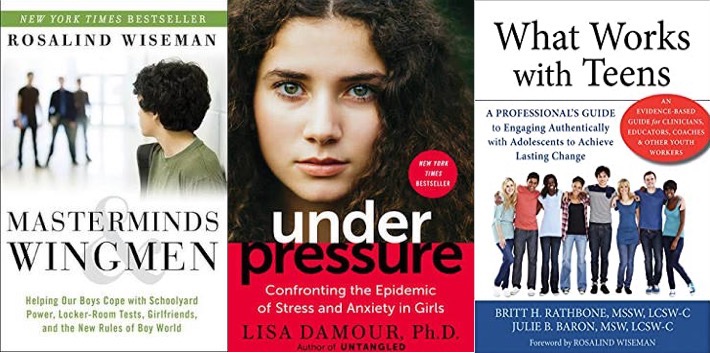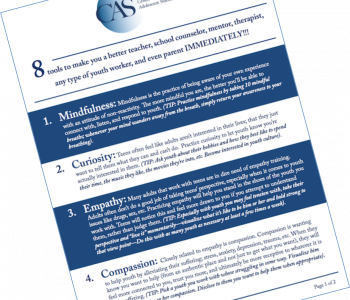

Catharine Hannay, MA
Catharine Hannay is the founder of MindfulTeachers.org and the author of Being You: A Girl’s Guide to Mindfulness, a workbook for teen girls on mindfulness, compassion, and self-acceptance.
4 “Must Read” Books if You Care About Teens
Here are four books I’ve found particularly helpful in understanding the challenges of today’s youth and how adults can effectively support them.
1) What Works with Teens: A Professional’s Guide to Engaging Authentically with Adolescents to Achieve Lasting Change by Britt Rathbone, MSSW LCSW-C and Julie Baron, MSW LCSW-C
Rathbone and Baron start with an overview of what they call “the Adolescent Operating System (A-OS)” including a brief explanation of brain development. The rest of the book delves into adult-teen dynamics, with an emphasis on some of the same core themes here at the Center for Adolescent Studies, including treating youth with respect, authenticity, and kindness.
There are checklists and worksheets to reflect on your own interactions with teens, as well as rating scales the kids can use to give feedback (particularly relevant for counselors). This could be eye-opening, as it’s not uncommon for youths’ perceptions to be quite different from the adults’ intent.
Here are a few representative quotes from teens about how adults were or weren’t helpful:
- “I had this therapist who always said, ‘I know what you mean,’ but I never really felt like he actually got how I felt.”
- “When I walked into my therapist’s office with my new nose piercing and saw the look on his face, I knew it wasn’t going to be a good session.”
- “When I tore my ACL, I asked my doctor if I would be able to play basketball next year at college. She was really honest about the pros and cons and uncertainty, and was also encouraging about rehab. Even though I was still scared about how I would heal, I appreciated how realistic and honest she was with me.”
2) Under Pressure: Confronting the Epidemic of Stress and Anxiety in Girlsby Lisa Damour, PhD
Drawing on her experiences as a parent, therapist, and researcher, Damour shares effective ways to help girls:
- deal with round-the-clock peer stress because of social media
- become ‘energy efficient’ at school instead of putting much more effort than necessary into maintaining good grades;
- navigate dating and hookup culture, moving beyond mere acquiescence into figuring out what they actually want from a romantic relationship; and
- handle conflict in a healthy way (which a lot of adults could use help with, as well!):
“A bulldozer deals with disagreements by running people over, while doormats allow themselves to be run over. The doormat with spikes employs passive-aggressive tactics. […] Girls often have elaborate doormat-with-spikes repertoires, because we don’t always help our daughters learn to recognize, accept, and directly express their angry feelings. […]
For healthy conflict, the guiding metaphor is a pillar. It stands up for itself without stepping on anyone else. But when conflict comes, to be a pillar is really hard […] I still find that when I’m miffed, my first impulse is to be a doormat with spikes […] and will sometimes even indulge in daydreaming about the passive-aggressive things I’d like to do when I’m mad. In my actions, however, I do try to be a pillar.” (p. 75; p. 79)
3) Masterminds and Wingmen: Helping Our Boys Cope with Schoolyard Power, Locker-Room Tests, Girlfriends, and the New Rules of Boy World by Rosalind Wiseman
This book is primarily for parents of boys 10 and up, with an emphasis on the teen years and the shifting dynamics from middle school to high school.
Rosalind Wiseman is also the author of Queen Bees and Wannabes, which became famous as the inspiration for Mean Girls. (I certainly recommend that book as well; I didn’t include here because more people are already familiar with it.) Masterminds and Wingmen takes a similar approach to understanding ‘Guy World,’ with kids weighing on on topics like:
- when and how to intervene when boys are in conflict with their peers or with other adults;
- how to respond if he’s witnessed, experienced, or participated in bullying;
- how to discipline boys in a way that’s effective (hint: grounding doesn’t work if they still have access to their electronics); and
- the subtle signals that he might want help… and when he really needs you to back off.
Wiseman lists dozens of boys who gave feedback as she was writing the book. She discovered that supposedly taciturn boys were eager to share their perspective:
“The boys made me realize that things I’d assumed about them for years were wrong. […] I gave them problems other kids wrote to me about, and they had intense debates about how to help these kids they didn’t even know, then emailed me because they were worried about what had happened to the kids in trouble. They shared their most personal stories, feelings, and opinions—all to help you know how to reach out to the boy in your life in the best possible way.” (p. 24)
4) Not Light but Fire: How to Lead Meaningful Race Conversations in the Classroom by Matthew Kay
High school teacher Matthew Kay says there’s no shortage of commentary about race: “We tweet, we post, we meme, we chat,” but somehow never get beyond the superficial, despite generations of discussions on the same issues.
A lot of Kay’s suggestions are useful for leading discussions on any powerful topic:
- the types of classroom relationships and interpersonal skills that create a safe space for students to share their views;
- how to handle potential conflict and hostility when discussing particularly contentious topics;
- how to challenge students without pushing them beyond their limits; and
- how to structure class sessions, including:
- how much time the teacher/facilitator should spend speaking and listening, and
- how much time the students might need to think through their ideas before sharing with the group.
Other suggestions relate specifically to discussions about race, ethnicity, and identity:
- guidelines on how to handle the N-word, depending on the teacher’s ethnicity; and
- the specific texts and writing assignments he uses in his classes, including:
- discussions about cultural appropriation; and
- discussions about names and ethnic identity.
The book’s title comes from a speech by Frederick Douglass in 1852.
“Douglass, along with many abolitionists, had often been chided for the honesty and directness of his race discourse. He was told that, instead of offering fiery rebukes, he should spend more time ‘shedding light’ on the country’s race problem. […] An exasperated Douglass finally responded, ‘On what branch of the subject do the people of this country need light?’ […] He called for us to infuse our conversations with fire—to seek out and value historical context, to be driven by authentic inquiry, and above all, to be honest—both with ourselves and with those with whom we share a racial dialogue. […]
“This is a book for educators who want to answer Douglass’ challenge: teachers who wish to tackle race conversations with more than a light show, who want something to be different” after engaging in thoughtful discussions with their students.” (p. 2-5)
All four of these books can help you to engage more deeply and authentically with the youth in your care. I hope you find them as useful as I do.
You’ll find many more resources for working with youth here at the Center for Adolescent Studies blog, including:
- 4 “Must Read” Books for Professionals Working with Traumatized Youth.
- 4 Qualities That Lead to Interpersonal Connection and Safety With Youth
- An INCRAmental Approach to Building Rapport with Youth
Join the FREE Resilience Community for Helping Professionals to learn more about trauma-informed care, resilience, mindfulness, building relationships, and more! Our community features self-paced courses, a monthly live Zoom call, a weekly live meditation, and an online platform to connect with other providers/professionals in your field.

